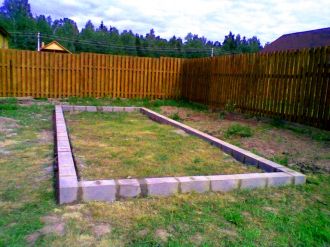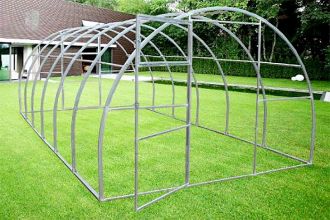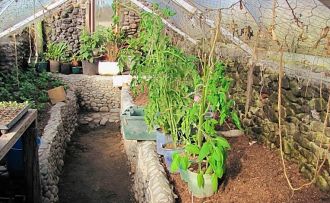Reliable do-it-yourself polycarbonate greenhouse: 7 steps

You can build a polycarbonate greenhouse on your own if you approach the process of arranging it correctly and competently Do-it-yourself polycarbonate greenhouse is not a myth, but a real reality that anyone can get close to. There are no specific nuances that are available for implementation exclusively to professionals in the construction industry. Of course, you can use their help, but such a service will cost an order of magnitude more expensive. It is better to learn and make a greenhouse yourself.
Beginning of the process: how to make a polycarbonate greenhouse
It all starts with the fact that the future master must decide on his desires. There are a lot of options for a polycarbonate greenhouse, but not all are suitable for specific conditions.
Before proceeding with the implementation of the process, it is recommended to look at dozens of options, and then select the one you like best. Further, each of the options you need to thoroughly study and choose the best one for yourself.
And it is not necessary to completely copy the designers' work! You can combine several of them with each other, and then get a radically new solution. Experts recommend that beginners keep in mind a certain algorithm of actions, with the help of which a greenhouse with their own hands will probably be built faster.
Before proceeding with the arrangement of a polycarbonate greenhouse, you must first consider its design and draw up a detailed drawing
Namely:
- Choosing a suitable greenhouse option;
- Creating an individual sketch based on it;
- Adjustments;
- Implementation of a full-fledged paper project;
- Calculation of required materials;
- Purchase of construction elements;
- Establishing an object.
The main thing is not to rush and strictly follow all the points of the plan. Maybe not right away, but everything will definitely work out. And every, even a small mistake, you need to be able to correct right away! Not hoping that later no one will notice her.
How to learn how to make a polycarbonate greenhouse with your own hands
There are only a few people who independently, without any help, learned to build objects. Everyone else needs to be trained. Today, in the age of information technology, this can be done much faster.
The easiest option is to take the help of an experienced friend who has already built a single greenhouse. Such a specialist will surely cover the whole process in an accessible way and give practical advice. However, not everyone has such acquaintances.
The only way out in this case is to watch thematic videos where professional builders teach amateurs how to build home-made carbonate garden greenhouses.
In addition, you can see a detailed master class that describes the process of building a greenhouse
Thanks to them, yesterday's clumsy will be able to:
- Get answers to the most pressing questions;
- Understand the general principle of operation;
- Learn how to build greenhouses;
- Choose the right materials;
- Avoid the most common rookie mistakes.
Lessons that involve interaction between students and teachers online are considered the best. Thus, the work is, as it were, carried out in a live mode, so the likelihood of questions arising during the construction of the structure is reduced to an absolute minimum. And, if there are any, you can always use the help of a teacher.
Is it worth saving: do-it-yourself polycarbonate greenhouses
The manufacture of a greenhouse does not require significant financial investments, however, some summer residents manage to save even more on this process. Structures are built from old building materials that have already been in use. And most builders believe that this is not correct. The thing is that a polycarbonate building is a capital object that is designed to last a single year. Of course, if you want to build it again in a year, you can take low-quality materials. But, as you know, the miser pays twice.
Many gardeners note that it is better to select high-quality materials for construction, since such a greenhouse will last for many years
A greenhouse made of new materials has the following advantages:
- Will last an order of magnitude longer;
- Aesthetically fits into the surrounding landscape;
- Protects plants more reliably;
- Provides optimal conditions for seedlings.
Of course, situations are different, so sometimes we build with exactly what we have in our arsenal. In this case, the annex needs to be strengthened as much as possible so that it can stand for at least a couple of years.
An outer coat of paint adds durability, making wood, metal, etc. stand out. are not exposed to external factors.
It also saves the fact that when the building is successfully modernized. So, in a few years, it can be changed beyond recognition.
Stages of building homemade polycarbonate greenhouses
The construction of the greenhouse begins with the marking of the adjacent territory. Along the perimeter of the site on which the attached greenhouse will stand, it is necessary to install small wooden pegs, which will serve as a guide. Further, dense wooden / metal supports are placed at the corners of the greenhouse. It is better to concrete them so that the building does not roll during operation.
When starting work, you should first dig a hole of the appropriate size and pour concrete into it, after placing the supports
You need to carry out this process in the following sequence:
- Dig a hole 30 - 40 cm deep;
- Pour about 10 cm of sand, which will become a shock-absorbing pillow;
- Place a support in the middle and pour concrete evenly;
- Wait until the solution hardens, and then proceed to further steps.
It's best to wait about a week if it's warm and sunny outside. The colder it is outside, the longer the concrete will harden. If rain is expected, it is better to cover the pits filled with concrete with cellophane.
After the structure has hardened, additional partitions can be installed, running perpendicular to the main pillars. This is necessary in order to subsequently cover it with polycarbonate protective sheets.
At the same time, one should not forget that the greenhouse, like the house, should have a door and windows. It's not hard to make them! It is enough just to install the structures on hinges.
Do I need ventilation in a polycarbonate greenhouse
Ventilation in a greenhouse is a mandatory attribute, without which it is not possible to provide plants with a normal microclimate. At the same time, the technology for building greenhouses in the country implies a very simple device.
An obligatory element of each greenhouse is ventilation, which ventilates the room and maintains a comfortable air temperature
A ventilation unit can be:
- Door;
- Window;
- A pipe coming out of the roof.
The first options are optimal, because they are extremely simple to implement. If the temperature rises, you can open the door or window yourself, providing fresh air. If it becomes cool in the greenhouse, you can hang trellises on the door and windows, which will protect the seedlings from drafts.
A do-it-yourself rectangular greenhouse is no different from the options made by professionals. It is important what material the structure is made of and how well it is assembled. Having got the hang of it, you can also create round greenhouses that look extremely uncommon. Such models are used in Kazakhstan.
Buy a polycarbonate greenhouse in the USA
 The fastest way is to build a greenhouse frame with your own hands from wood. It is possible that a wooden greenhouse will be somewhat higher in cost than one made of a metal profile (aluminum or steel), but the environmental friendliness wood áis many times superior to any other building material.
The fastest way is to build a greenhouse frame with your own hands from wood. It is possible that a wooden greenhouse will be somewhat higher in cost than one made of a metal profile (aluminum or steel), but the environmental friendliness wood áis many times superior to any other building material.




Comments on this post are no longer accepted.